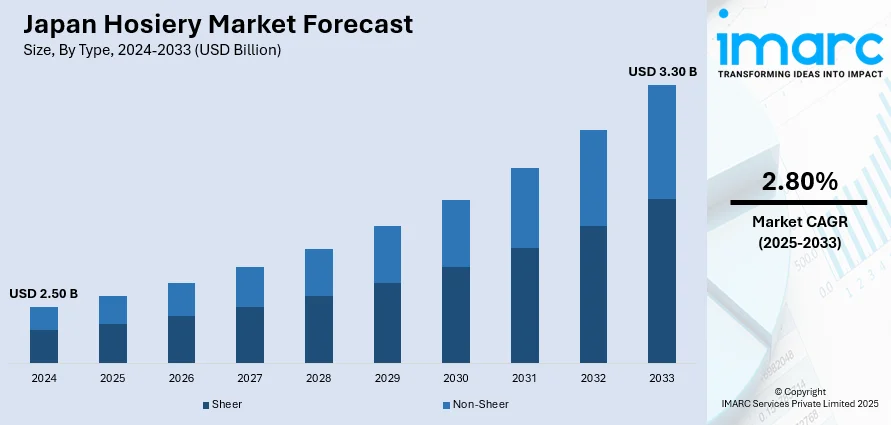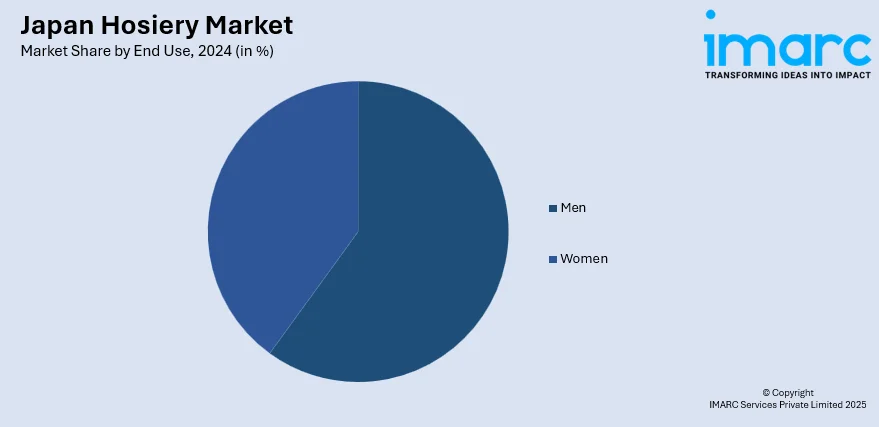
Japan Hosiery Market Size, Share, Trends and Forecast by Type, End Use, and Region, 2025-2033
Japan Hosiery Market Overview:
The Japan hosiery market size reached USD 2.50 Billion in 2024. Looking forward, IMARC Group expects the market to reach USD 3.30 Billion by 2033, exhibiting a growth rate (CAGR) of 2.80% during 2025-2033. The market is driven by enduring cultural standards favoring modest, polished dressing supported by seasonal wardrobe needs. Domestic innovations in textile manufacturing are advancing quality, functionality, and sustainability across product ranges, thereby fueling the market. The growing demand for compression and comfort hosiery, especially among the aging population, is enhancing category growth, which is further augmenting the Japan hosiery market share.
|
Report Attribute
|
Key Statistics
|
|---|---|
|
Base Year
|
2024 |
|
Forecast Years
|
2025-2033
|
|
Historical Years
|
2019-2024
|
| Market Size in 2024 | USD 2.50 Billion |
| Market Forecast in 2033 | USD 3.30 Billion |
| Market Growth Rate 2025-2033 | 2.80% |
Japan Hosiery Market Trends:
Technological Innovation in Hosiery Textiles and Design
Japan's advanced textile manufacturing ecosystem continues to enable high-precision hosiery innovations that align with the market's expectations for quality, comfort, and durability. Hosiery brands are leveraging developments in ultra-fine yarns, seamless knitting, and dual-purpose fabrics to introduce products that resist runs, adapt to body temperature, and offer UV protection. These materials are increasingly designed to deliver compression benefits without compromising visual elegance. According to industry reports, in 2023, Japan's production volume of pantyhose made from knitted fabrics increased by 6.9 million units, marking a 17.09% growth compared to the previous year. Companies are also focusing on advanced waistband structures, reinforced toes, and moisture-wicking panels to increase wearability for long hours. Innovation extends into sustainable production, with leading domestic brands incorporating recycled nylon, biodegradable packaging, and closed-loop dyeing techniques. The use of AI-driven knitting machines ensures consistent sizing and efficient mass customization, supporting retail agility. Japanese consumers, known for their discerning quality standards, reward these enhancements with strong brand loyalty and repeat purchases. Furthermore, strategic collaborations between hosiery manufacturers and fashion houses contribute to limited-edition collections that blend function and high fashion, supporting brand prestige and pricing power. This technology-led product evolution reflects the country's broader textile leadership and elevates hosiery's perceived value in a mature, design-conscious market. The integration of seasonal functionality with cultural norms drives consistent demand, ultimately contributing to Japan hosiery market growth.

Aging Demographics and Demand for Supportive Hosiery
Japan's aging population, among the highest globally, is significantly shaping demand for supportive and therapeutic hosiery. Compression stockings and circulation-enhancing tights are increasingly recommended by healthcare professionals to address chronic venous insufficiency, swelling, and post-operative recovery. A recent study on compression stockings for vascular disorders used the Taguchi-TOPSIS method to optimize comfort. Main yarn linear density (120 denier nylon) had the largest impact on comfort properties, contributing 42%, followed by plaiting yarn linear density (31%) and structure (7%). The optimum combination for comfort was 120 denier nylon main yarn and 70 denier nylon plaiting yarn, with an experimental error of 8.5%. Elderly consumers also turn to such products for daily comfort and preventive care, particularly in managing long periods of standing or sedentary activity. The shift toward home-based elder care and outpatient treatments supports increased retail availability through pharmacies, health specialty stores, and e-commerce platforms. Functional hosiery is also finding a place in the wellness routines of middle-aged adults, especially women, who use mild compression products to manage fatigue or varicose discomfort. Brands are adapting designs to emphasize ease of wear, skin sensitivity, and breathable materials, ensuring compliance among older users. Importantly, these functional variants retain aesthetic appeal, eliminating the stigma once associated with medical-grade garments. Packaging that clearly communicates benefits in easy-to-read formats further improves accessibility. As Japan continues to adjust to its demographic realities, hosiery products that integrate wellness benefits with daily usability are becoming an essential segment across retail and healthcare channels.
Japan Hosiery Market Segmentation:
IMARC Group provides an analysis of the key trends in each segment of the market, along with forecasts at the country and regional levels for 2025-2033. Our report has categorized the market based on type and end use.
Type Insights:
- Sheer
- Non-Sheer
The report has provided a detailed breakup and analysis of the market based on the type. This includes sheer and non-sheer.
End Use Insights:

- Men
- Women
The report has provided a detailed breakup and analysis of the market based on the end use. This includes hosiery products for men and women.
Regional Insights:
- Kanto Region
- Kansai/Kinki Region
- Central/Chubu Region
- Kyushu-Okinawa Region
- Tohoku Region
- Chugoku Region
- Hokkaido Region
- Shikoku Region
The report has also provided a comprehensive analysis of all major regional markets. This includes Kanto Region, Kansai/Kinki Region, Central/Chubu Region, Kyushu-Okinawa Region, Tohoku Region, Chugoku Region, Hokkaido Region, and Shikoku Region.
Competitive Landscape:
The market research report has also provided a comprehensive analysis of the competitive landscape. Competitive analysis such as market structure, key player positioning, top winning strategies, competitive dashboard, and company evaluation quadrant has been covered in the report. Also, detailed profiles of all major companies have been provided.
Japan Hosiery Market News:
- On March 8, 2024, Sukeno launched a new series of "Liite" compression socks, designed with input from midwives to cater to pregnant women’s needs. The new line includes three variations: a natural fiber high sock, a toeless option for broader support, and a thin, high sock for comfort in warm weather. The product line also features updated color options and improved designs based on feedback from exhibitions.
Japan Hosiery Market Report Coverage:
| Report Features | Details |
|---|---|
| Base Year of the Analysis | 2024 |
| Historical Period | 2019-2024 |
| Forecast Period | 2025-2033 |
| Units | Billion USD |
| Scope of the Report | Exploration of Historical Trends and Market Outlook, Industry Catalysts and Challenges, Segment-Wise Historical and Future Market Assessment:
|
| Types Covered | Sheer, Non-Sheer |
| End Uses Covered | Men, Women |
| Regions Covered | Kanto Region, Kansai/Kinki Region, Central/Chubu Region, Kyushu-Okinawa Region, Tohoku Region, Chugoku Region, Hokkaido Region, Shikoku Region |
| Customization Scope | 10% Free Customization |
| Post-Sale Analyst Support | 10-12 Weeks |
| Delivery Format | PDF and Excel through Email (We can also provide the editable version of the report in PPT/Word format on special request) |
Key Questions Answered in This Report:
- How has the Japan hosiery market performed so far and how will it perform in the coming years?
- What is the breakup of the Japan hosiery market on the basis of type?
- What is the breakup of the Japan hosiery market on the basis of end use?
- What is the breakup of the Japan hosiery market on the basis of region?
- What are the various stages in the value chain of the Japan hosiery market?
- What are the key driving factors and challenges in the Japan hosiery market?
- What is the structure of the Japan hosiery market and who are the key players?
- What is the degree of competition in the Japan hosiery market?
Key Benefits for Stakeholders:
- IMARC’s industry report offers a comprehensive quantitative analysis of various market segments, historical and current market trends, market forecasts, and dynamics of the Japan hosiery market from 2019-2033.
- The research report provides the latest information on the market drivers, challenges, and opportunities in the Japan hosiery market.
- Porter's five forces analysis assist stakeholders in assessing the impact of new entrants, competitive rivalry, supplier power, buyer power, and the threat of substitution. It helps stakeholders to analyze the level of competition within the Japan hosiery industry and its attractiveness.
- Competitive landscape allows stakeholders to understand their competitive environment and provides an insight into the current positions of key players in the market.
Need more help?
- Speak to our experienced analysts for insights on the current market scenarios.
- Include additional segments and countries to customize the report as per your requirement.
- Gain an unparalleled competitive advantage in your domain by understanding how to utilize the report and positively impacting your operations and revenue.
- For further assistance, please connect with our analysts.
 Request Customization
Request Customization
 Speak to an Analyst
Speak to an Analyst
 Request Brochure
Request Brochure
 Inquire Before Buying
Inquire Before Buying




.webp)




.webp)












